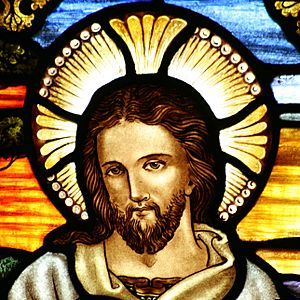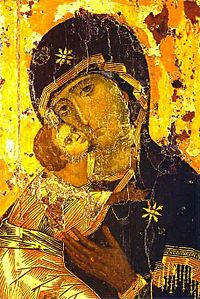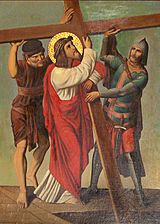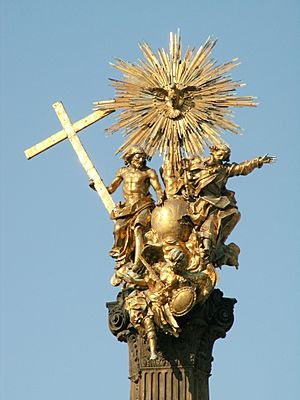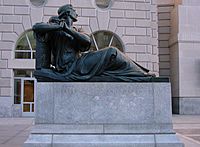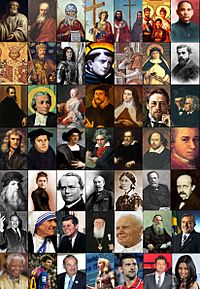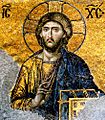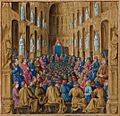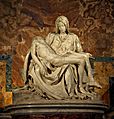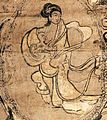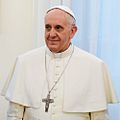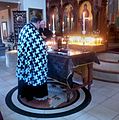Christianity facts for kids
Christianity is the world's largest religion, with about 2.4 billion followers. People who follow Christianity are called Christians. They generally believe that Jesus is the Son of God and part of the Trinity. Christianity is a monotheistic religion, meaning Christians believe in only one God. Their faith is based on the life and teachings of Jesus of Nazareth.
During his time, Jesus was known as a preacher, teacher, healer, and prophet from ancient Judea. His followers believed he was much more: God's only son, sent to Earth to die on a cross for people's sins. Jesus was executed by being nailed to a cross (this is called crucifixion) under Pontius Pilate, the Roman governor. Stories about his life and followers are found in the New Testament, which is part of the Bible. Christians see the Bible, both the Old and New Testaments, as sacred (holy). The Gospels, meaning "The Good News," are the first four books of the New Testament. They tell about Jesus's life, his death, and how he rose from the dead.
Christians believe God created the world. They believe Jesus is the Son of God. They also believe he was born as a human through the Virgin Mary and that he is also fully divine. They believe he suffered and died to free humans from their sins, and then was raised from the dead. After that, he went up into Heaven. Christians believe Jesus will return to Earth one day to judge everyone, giving everlasting life to those who believe in him. The Holy Spirit is God's spirit on Earth, which spoke through prophets.
Prophets in the Old Testament had foretold the coming of Jesus as the Savior. Christians see Jesus Christ as a teacher, a role model, and someone who showed them who the Christian God is.
Like Judaism and Islam, Christianity is an Abrahamic religion. It began as a Jewish group in the eastern Mediterranean. It quickly grew in followers and power over a few decades. By the 4th century, it became the main religion in the Roman Empire. The Kingdom of Aksum was the first empire to become Christian. During the Middle Ages, most of Europe became Christian. At that time, Christians were a smaller group in the Middle East, North Africa, and parts of India. After the Age of Discovery, missionaries and colonization helped Christianity spread to Africa, the Americas, and the rest of the world.
Christianity has played a big part in shaping the world. In the early 21st century, there are about 2.2 billion Christians.
Contents
- Jesus Christ: God's Son and Savior
- Jesus's Death and Resurrection
- Salvation in Christianity
- Holy Writings: The Bible
- Creeds: Statements of Belief
- The Trinity: One God, Three Persons
- The Afterlife and End Times
- Christian Worship
- History of Christianity
- Types of Christianity
- Christian Population Around the World
- Working Together: Ecumenism
- Related Pages
- Images for kids
- See also
Jesus Christ: God's Son and Savior
The most important part of Christianity is believing in Jesus as the Son of God and the Messiah (Christ). The word "Messiah" comes from the Hebrew word māšiáħ, meaning "anointed one." The Greek word Christos is where we get the English word "Christ."
Christians believe that Jesus, as the Messiah, was chosen by God to be the ruler and savior of all people. They also believe Jesus's coming fulfilled prophecies from the Old Testament. A key Christian belief is that through Jesus's death and resurrection, people who have sinned can become friends with God again. This gives them salvation and eternal life.
Over the first centuries of Christianity, there were many discussions about who Jesus was. But Christians generally believe that Jesus is God in human form and "true God and true man." Jesus became fully human, felt pain and temptations like any person, but he did not sin. As fully God, he defeated death and came back to life. The Bible says God raised him from the dead, he went up to heaven, and he will return to fulfill other Messianic prophecies, like the raising of the dead, the Last Judgment, and the final creation of the Kingdom of God.
The Gospels of Matthew and Luke say that Jesus was conceived by the Holy Spirit and born from the Virgin Mary. The Bible tells us little about Jesus's childhood, but much about his adulthood, especially the week before his death. Some of the Biblical stories about Jesus's work include his baptism, miracles, preaching, teaching, and deeds.
Jesus's Death and Resurrection
Christians believe the resurrection of Jesus is the most important part of their faith (see [1 Corinthians 15]). It shows that Jesus has power over death and can give people eternal life.
The death and resurrection of Jesus are two main events in Christian belief. The New Testament says Jesus was crucified, died a physical death, was buried in a tomb, and rose from the dead on the third day. Most Christians remember his death on a Friday (Good Friday) and his resurrection on a Sunday (Easter Sunday). The New Testament says Jesus appeared many times to his Twelve Apostles and disciples, and once to "more than five hundred brethren at once," before he went up to heaven. Christians remember Jesus's death and resurrection in their worship services, especially during Holy Week, which includes Good Friday and Easter Sunday.
Salvation in Christianity
Protestantism teaches that eternal salvation is a gift from God's grace. This means God brings people into a good relationship with Him through faith in Jesus Christ. It is the belief that one can be saved from sin and death forever. Many Protestants believe in "assurance of salvation," meaning God can give a believer confidence that they have truly received salvation.
Catholicism teaches that usually, someone must be baptized Catholic to be saved. However, it is sometimes possible for people who are not fully part of the Catholic Church to be saved. Catholics believe in the importance of "faith working through love" and sacraments to receive salvation. The Catholic Church teaches that good works and holiness, like obeying commands, taking sacraments, going to church, doing penance, giving charity, and praying, are important for becoming holy. But they strongly emphasize that salvation comes only through God's grace, and people can only receive it.
Different Christian groups have different ideas about divine grace. Roman Catholicism and Eastern Orthodoxy teach that free will is important for working with grace. Reformed theology teaches that people cannot save themselves, but God's grace can change even an unwilling heart. Arminianism believes in a synergistic view (meaning people work with God's grace), while Lutheran and most other Protestant groups teach justification by grace through faith alone.
Holy Writings: The Bible
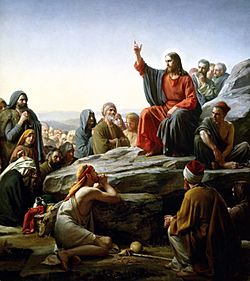
Christians use the Bible, which is a collection of many holy books. It has two main parts: the Old Testament and the New Testament. Christians believe these books were written by people who were inspired by the Holy Spirit, so they are often believed to be the word of God. The Bible has been translated into over 600 languages. Translators check its accuracy by using thousands of old handwritten copies in the original languages of Hebrew, Aramaic, and Greek.
Creeds: Statements of Belief
Creeds come from the Latin word credo, meaning "I believe." They are clear statements or declarations, usually about religious beliefs. They started as phrases used when someone was baptized. During arguments about Jesus's nature in the 4th and 5th centuries, they became important statements of faith.
Some main Christian creeds are:
- The Apostles' Creed (Symbolum Apostolorum)
- The Nicene Creed
Many Christians accept and use these creeds. A smaller number of Protestants, especially Restorationists (a movement from the 19th century in the United States), do not use creeds.
The Trinity: One God, Three Persons
The Bible mentions God the Father, God the Son (Jesus Christ), and the Holy Spirit. Yet, Christians believe there is only one God. This idea, called the Trinity, was discussed at the First Council of Nicaea in 325 AD and developed further at other church meetings. Today, many Christian groups agree with it. Oriental Orthodox Churches did not agree with some later ideas and separated after certain councils. The largest Oriental Orthodox Church is the Coptic Orthodox Church.
Trinitarianism is the teaching that God is three different persons, or has three different relationships, within One God: the Father, the Son (Jesus Christ), and the Holy Spirit. As the Athanasian Creed says, "the Father is God, the Son is God, and the Holy Spirit is God, and yet there are not three Gods but one God."
Most Christian denominations and Churches today believe in the Trinity. Churches have different teachings about how the Trinity works. Some say the Spirit comes only from the Father. Others say the Spirit comes from both the Father and the Son (this is called filioque). Nontrinitarianism (sometimes called Oneness) refers to Christian beliefs that reject the Trinity. Many different non-Trinitarian views existed in early Christianity, leading to discussions about Christology.
The Afterlife and End Times
Christians believe that people will be judged by God and will receive either eternal life or eternal damnation. This includes the "Last Judgment" and the belief that each soul is judged after death.
There are some differences in these beliefs among Christians. For example, in Roman Catholicism, those who die in a state of grace may go to purgatory, where they are cleansed before going to heaven.
Christians believe that at the second coming of Christ, all who have died will be raised from the dead for the Last Judgment, when Jesus will set up the Kingdom of God. There is also the belief of Universal Reconciliation, which means all people will someday be saved, and hell is not forever. Christians who believe this are called Universalists.
Christians have different ways of explaining why Jesus came:
- To teach the best way to live and to be an example to follow.
- To pay the price for sin in our lives by being the perfect sacrifice, without sin (John 3:16).
- To tell people that their mistakes and sins will be forgiven and they will be saved if they believe and have faith in Jesus and confess their sins (1 John 1:9, John 3:16, Ephesians 1:7, Romans 10:9).
- To teach people to forgive each other and to turn away from their own sin through grace (Matthew 6:14).
- To "destroy the devil's work" (1 John 3:8).
- To help people share in his life through the gift of God's Spirit.
Christian Worship
Worship is seen by most Christians as a very important part of their faith throughout its history. Many Christian thinkers have called humanity homo adorans, meaning "worshiping person." This means that worshiping God is central to being human, because God created all humanity. Christians believe they should worship and praise God.
Most Christian worship includes reading from the Bible, a talk about the Bible from a leader, singing, praying together, and a short time for church activities. Christians may meet in special buildings called Churches, or outdoors, or at schools, or wherever they feel they are needed.
The main worship service in Catholic Churches is called the Mass, and in many Orthodox Churches, it is called the Divine Liturgy. In both of these Churches, the Eucharist or Communion is a central part of worship. During this, a priest prays and asks God to change a small amount of bread and wine into what Catholics and Orthodox believe is Jesus's real body and blood, but without changing how the bread and wine look, taste, or feel. Then, people may receive a portion. Many Protestant churches have worship services similar to the Mass, some every week, others a few times a year. Some Protestants believe Jesus is truly present at Communion, while others believe the bread and wine are symbols to help them remember what Jesus did.
The Catholic Church has a short ceremony called Eucharistic Benediction, where they worship Jesus present in the Eucharist. They may also visit a Church to pray in the presence of the Eucharist, which is called Eucharistic Adoration.
Orthodox and Catholic Churches value the use of human senses and beautiful things in their spirituality. Catholic spirituality often uses statues, other art, candles, incense, and other physical items as reminders or aids for prayer. Orthodox Churches also use candles, incense, bells, and icons, but not statues. Orthodox and Catholic worship also includes movements, such as the Sign of the Cross (touching the forehead, chest, and shoulders), bowing, kneeling, and prostration.
Sacraments: Holy Rites
In Catholic belief and practice, a sacrament is a religious symbol or rite that shows divine grace, blessing, or holiness for the Christian who receives it. Examples are Baptism and the Mass. The word comes from the Latin word sacramentum, which was used to translate the Greek word for mystery.

The two most commonly used sacraments are Baptism and Eucharist (communion). Most Catholics use seven Sacraments: Baptism (a ritual immersion to welcome someone into the church); Confirmation (sealing the Covenant); the Eucharist (where consecrated bread and wine representing Jesus' body and blood are consumed); Holy Orders; Reconciliation of a Penitent (confession); Anointing of the Sick; and Marriage. Some Christian groups prefer to call them ordinances. These are commands from Christ to all believers found in the New Testament.
Liturgical Calendar: Holy Days
Roman Catholics, Anglicans, Eastern Christians, and traditional Protestant groups organize their worship around a liturgical calendar. This calendar includes "holy days" like solemnities that honor events in Jesus's life or the saints, times of fasting like Lent, and other events. Christian groups that don't follow a liturgical tradition often still celebrate Christmas, Easter, and Pentecost. A few churches do not use a liturgical calendar at all.
Christian Symbols
These are some symbols that different Christian groups or individual churches might use:
- Alpha and Omega - These are the first and last letters of the Greek alphabet. They refer to God, who calls himself the "Alpha and Omega" in the Book of Revelation.
- Chi - The Greek letter Chi is the first letter of 'Christ' (Greek: Χριστός).
- Chi Rho - The Greek letters Chi and Rho are the first two letters of 'Christ' in Greek.
- Christian cross - The cross is the most common symbol of Christianity. Christians believe that their savior Jesus Christ was crucified by the Romans. The cross is important because Jesus died as a sacrifice for the sins of believers. It shows God's love for humanity.
- Crucifix - The crucifix is a cross with the body of Jesus still on it. It is more popular with Catholics and Eastern Orthodox Christians. It has the same meaning as the cross.
- Dove - The dove is a bird and a symbol of the Holy Spirit. When Jesus was baptized, the Holy Spirit came to him like a dove.
- Ichthys - In Greek, ichthys means 'fish'. It forms an acronym for "Ίησοῦς Χριστός, Θεοῦ Υἱός, Σωτήρ," which means "Jesus Christ, God's Son, Savior" in Greek.
- Lamb - A lamb can symbolize Jesus himself, shown as the sacrifice for humans.
- Shepherd - A shepherd is also a symbol of Jesus himself and is used in early Christian art. In the Bible, Jesus calls himself the good shepherd who cares for his sheep.
- INRI - INRI is a Latin acronym for "Iēsus Nazarēnus, Rēx Iūdaeōrum," meaning "Jesus the Nazarene, King of the Jews." This message was put on the cross as the reason for his punishment. Christians now use it as a symbol that Jesus is the Messiah, or King of all kings.
- Interlocking rings - Three interlocking rings symbolize the Trinity. Each ring is a complete circle, representing each person of the Trinity. But each ring is locked with the other two, showing that each divine person cannot be separated from the Trinity.
History of Christianity
Christianity has a long history, from the time of Jesus and his apostles to today. It began in the 1st century AD as a Jewish group but quickly spread throughout the Greco-Roman world. Even though it was first persecuted by the Roman Empire, it later became the official state religion. In the Middle Ages, it spread into Northern Europe and Russia. During the Age of Exploration, Christianity expanded worldwide, and it is now the largest religion.
The religion has had splits and disagreements that led to ten main branches or groups: Catholicism, Eastern Orthodoxy, the Church of the East, Oriental Orthodoxy, Lutheranism, the Reformed churches, Anglicanism, Anabaptism, Evangelicalism (these last five are often called Protestant), and Nontrinitarianism.
Types of Christianity

People who call themselves Christians may practice their faith in different ways and believe different things. Historically, the ten main groups or "denominations" of Christianity have been the Orthodox, the Church of the East, the Oriental Orthodox, the Catholic, the Anglican, the Lutheran, the Reformed, the Anabaptist, the Evangelical, and the Non-Trinitarian churches. The last six are often grouped as Protestant, but Non-Trinitarians are often grouped separately. Not all Christians use these titles, and some believe Christianity is broader or narrower than these categories.
Disagreements and Divisions
Some of these groups disagreed on certain points of Christian teaching (called “doctrine”) or practice. The first major split happened in the 5th century after the Church Council of Ephesus, which declared Nestorianism wrong. The Assyrian Church of the East disagreed and separated. The argument was about the nature of Jesus: whether he had one combined nature (God and human) or two separate natures. Most bishops, following the Pope (the Bishop of Rome), insisted on "two separate natures." This was also discussed at the Council of Chalcedon about 20 years later. Christians who disagreed with the Council's decision became the non-Chalcedonian Orthodox. The largest Non-Chalcedonian Churches include the Coptic Orthodox in Egypt, the Ethiopian Orthodox, the Armenian, and some Lebanese Orthodox Churches. These are generally known as Oriental Orthodox Churches.
The third major split, called the Great Schism, happened in the 11th century. It was mainly due to a creed being translated incorrectly from Greek into Latin. Differences in culture also made the disagreements worse. Also, many Crusaders from Western Europe behaved badly. Christians in Western Europe were led by the Bishop of Rome (the Pope) and are called the Catholic Church. Most Christians in Eastern Europe, Russia, the Middle East, South Asia, and northeast Africa belong to Orthodox, Nestorian, and Miaphysite Christianity, led by Bishops of other cities or areas.
In the 15th century, the invention of the printing press made it easier for more people to read and study the Bible. This led many thinkers to return to biblical ideas and break away from the Catholic Church. This started the Protestant Reformation. Important Protestant leaders included Martin Luther and John Calvin. Later, some of these groups disagreed among themselves, leading to further splits into smaller groups. The largest Protestant groups today are within Evangelical, Lutheran, and Reformed Christianity. In England, a similar protest against the Pope led to the Church of England, which has bishops and calls itself Reformed Catholic but is often seen as Protestant. The Anglican communion includes churches called "Episcopal" or "Episcopalian" because they have bishops. Some Anglican Churches worship more like Protestants, while others are closer to Catholics, but none accept the Pope.
Here are some common disagreements among Christian groups:
- Groups have different ideas about the nature of God.
- Groups have different ideas about the Holy Spirit's role in a believer's life.
- The pope is the leader of all Catholics. Other churches have leaders similar to the pope, like Patriarchs in the Eastern Orthodox Church. Still other groups let each local church decide things.
- Some Christians say women cannot become priests or pastors.
- Some Christians say married people cannot become priests.
- Some Christians believe priests can forgive sins by giving God's forgiveness, while others say only God can do this.
- In modern times, some Christians believe in "Young Earth Creationism," meaning a literal interpretation of the Bible's first chapters. Others believe those parts of the Bible are more like poetry than literal history.
- Most Christians worship on Sunday, but some believe Saturday is the true "Sabbath" and should be kept.
- Some Christians believe baptism must mean going fully underwater, while others sprinkle water on the head.
- Some Christian groups baptize babies, while Baptists only baptize people who have chosen to follow Jesus themselves.
Christian Population Around the World
With an estimated 2.2 billion Christians, split into about 34,000 different denominations, Christianity is the world's largest religion. The percentage of Christians in the world's population has been around 33% for the last hundred years. Christianity is still the main religion in Europe, the Americas, the Philippines, and Southern Africa. However, it is becoming smaller in some areas, such as Oceania (Australia and New Zealand), Northern Europe (including Great Britain and Scandinavia), France, Germany, parts of Canada and the United States, and parts of Asia (especially the Middle East, South Korea, Taiwan, and Macau).
In most developed countries, the number of people attending church who say they are Christians has been falling over the last few decades. Some believe this is because many no longer join churches regularly, while others think it's because people might feel religion is no longer important.
Working Together: Ecumenism
Most churches have long shown they want to be tolerant of other belief systems. In the 20th century, Christian ecumenism (the uniting of Christians from different backgrounds) grew in two ways. One way was more cooperation between groups, such as the Edinburgh Missionary Conference of Protestants in 1910, and the Justice, Peace and Creation Commission of the World Council of Churches, started in 1948 by Protestant and Orthodox churches. Similar national councils, like the National Council of Churches in Australia (which includes Roman Catholics), also formed.
The other way was creating unions for different churches to join together. Congregationalist, Methodist, and Presbyterian churches joined in 1925 to form the United Church of Canada, and in 1977 to form the Uniting Church in Australia. The Church of South India was formed in 1947 by the union of Anglican, Methodist, Congregationalist, Presbyterian, and Reformed churches. Other such unions have been made by different Christian groups over the years.
Related Pages
Images for kids
-
An Eastern Christian icon showing Emperor Constantine and the Fathers of the First Council of Nicaea (325) holding the Niceno–Constantinopolitan Creed of 381.
-
Crucifixion, showing the death of Jesus on the Cross, painting by Diego Velázquez, c. 1632.
-
Midnight Mass at a Catholic parish church in Woodside, New York City, U.S.
-
A show about the life of Jesus at Igreja da Cidade in São José dos Campos, Brazil.
-
An early circular ichthys symbol, created by combining the Greek letters ΙΧΘΥΣ into a wheel, Ephesus, Asia Minor.
-
The Bible is the sacred book in Christianity.
-
The Cenacle on Mount Zion in Jerusalem, believed to be the location of the Last Supper and Pentecost.
-
A page from Papyrus 46, an early-3rd-century collection of Pauline epistles.
-
The Monastery of St. Matthew, one of the oldest Christian monasteries, located in northern Iraq.
-
The 7th-century Khor Virap monastery near Mount Ararat; Armenia was the first state to adopt Christianity as its state religion in AD 301.
-
Christendom by A.D. 600 after its spread to Africa and Europe from the Middle East.
-
An example of Byzantine art, the Deësis mosaic at the Hagia Sophia in Constantinople.
-
Pope Urban II at the Council of Clermont, where he called for the First Crusade. Illustration by Jean Colombe, c. 1490.
-
Martin Luther started the Reformation with his Ninety-five Theses in 1517.
-
Michelangelo's 1498–99 Pietà in St. Peter's Basilica; the Catholic Church supported the Renaissance.
-
A depiction of Madonna and Child in a 19th-century Kakure Kirishitan Japanese woodcut.
-
A Christian procession in Brazil, the country with the largest Catholic population.
-
Trinity Sunday in Russia; the Russian Orthodox Church has seen a great revival since the fall of communism.
-
St. George's Cathedral in Istanbul: It is the seat of the Ecumenical Patriarchate of Constantinople, whose leader is seen as the primus inter pares (first among equals) in the Eastern Orthodox Church.
-
Holy Trinity Cathedral in Addis Ababa, the seat of the Ethiopian Orthodox.
-
A 6th-century Nestorian church, St. John the Arab, in the Assyrian village of Geramon in Hakkari, southeastern Turkey.
-
A 19th-century drawing of Joseph Smith and Oliver Cowdery receiving the Aaronic priesthood from John the Baptist. Latter Day Saints believe the Priesthood ended after the apostles' deaths and needed to be restored.
-
A copy of the Summa Theologica by Thomas Aquinas, a famous Christian book.
-
Service of the Sacrament of Holy Unction served on Great and Holy Wednesday.
See also
 In Spanish: Cristianismo para niños
In Spanish: Cristianismo para niños


